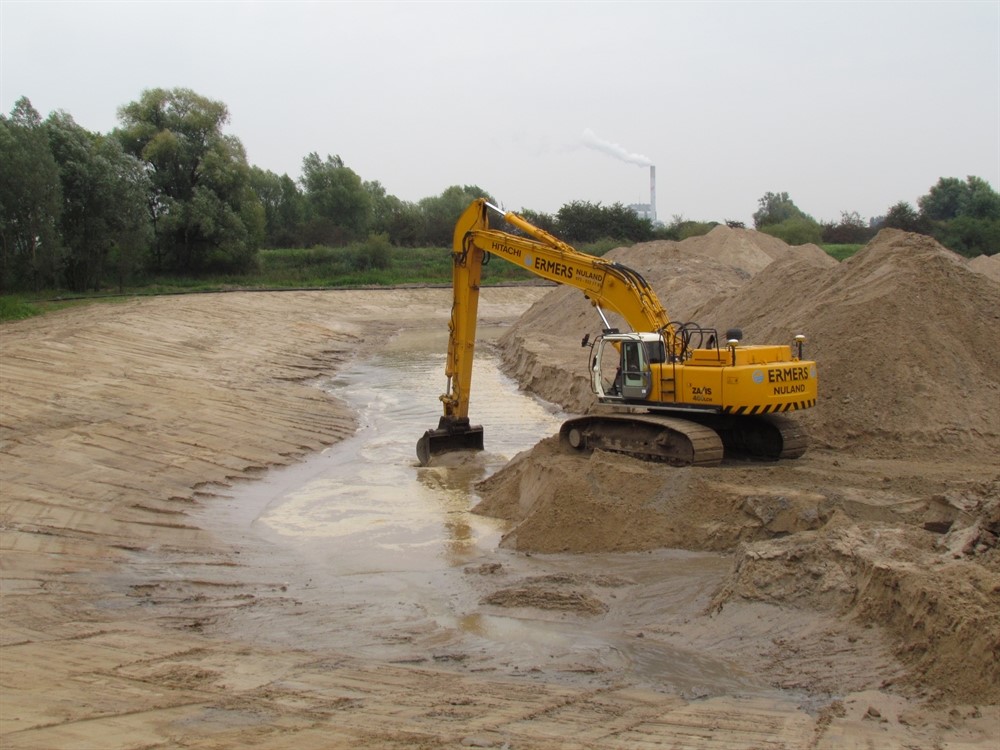Beuningen Natural Climate Buffer
Between 2013 and 2018, the municipality of Beuningen, ARK Nature, Rijkswaterstaat and several other parties created a new climate buffer in the Beuningen floodplains in order to combat flooding caused by high water levels in the river Waal. Additionally, they aimed to enhance nature and biodiversity, and to boost the area’s appeal to visitors. The construction of this new climate buffer was imperative because local measures taken earlier failed to provide sufficient flood protection.

What measures had already been taken?
In the past, the Ewijk shallow protected the area against flooding caused by high Waal river water levels. The Ewijk shallow is an elongated peninsula on the south bank of the river Waal, which was excavated to create more room for the river. Rijkswaterstaat last excavated this shallow in 1989. Following completion of the project in 1989, ARK had the area grazed by Konik ponies and cattle. Apart from that, nature could run its course. However, in 2011, it was found that sand transported by the river and the development of riparian woodland could raise flood water levels by several centimetres. By introducing a different form of nature management, ARK was able to counteract this to some degree.
Cyclic rejuvenation
In the purview of combating flooding, ARK has been pursuing a new form of nature management on the Ewijk shallow, together with Rijkswaterstaat, since 2011: cyclic rejuvenation. This entails that ARK is discouraging high riverbank vegetation, thus periodically “rejuvenating” nature in order to foster natural erosion and biodiversity. In addition, Rijkswaterstaat has dug channels that are connected to openings in the riverbank. All these measures help to discharge river water during periods of high water levels. However, the new climate buffer called for additional measures.
View a short film via Youtube: Sunday morning by the river Waal: a short human interest impression of the Beuningen floodplains.
Measures for the new climate buffer
The parties involved coordinated the new climate buffer measures with the work being done on the Ewijk shallow. The new climate buffer was intended to lower the flood water level by more than four centimetres. To achieve this goal, a large channel was dug in the Beuningen floodplains in 2014, which can fill up during periods of high water levels. The channel is shaped like a horseshoe, surrounding a small peninsula with willow trees. The project was postponed by six months in order to protect the vulnerable Northern Crested Newt in the area.
What results have been achieved?
The main result is that the project has reduced the flood water level by four centimetres. Furthermore, excellent results have been achieved in terms of nature. Rijkswaterstaat has supported the preservation of part of the riverbank woodland. Upon completion of the project, little ringed plovers rapidly took to the new sandy banks to build their nests. The first plants that started to grow included water mudwort, Pulicaria vulgaris, and golden dock. The area also attracted many dragonflies and birds, such as common greenshank and common spoonbill.
Which parties have collaborated on this climate buffer?
ARK Nature and the municipality of Beuningen have carried out this project in collaboration with Rijkswaterstaat, the Rivierenland district water board, Staatsbosbeheer, the Rural Areas Service, and the Stroming agency.
Contact person
Bart Beekers
ARK Natuurontwikkeling
06-20446387
bart.beekers@ark.eu
